AUDI TT COUPE 2016 Owners Manual
Manufacturer: AUDI, Model Year: 2016, Model line: TT COUPE, Model: AUDI TT COUPE 2016Pages: 322, PDF Size: 52.86 MB
Page 181 of 322

Downloaded from www.Manualslib.com manuals search engine Transport Canada, Defect Investi
gations and Recalls, may either
call Transport Canada toll-free at:
Tel.: 1-800-333-0510 or
Tel.: 1-819-994-3328 (Ottawa re
gion
and from other countries)
TTY for hearing impaired: Tel.:
1-888-67 5-6863
or contact Transport Canada by
mail at:
Transport Canada
Motor Vehicle Safety Investiga
tions Laboratory
80 Noel Street
Gatineau, QC
J8Z OAl
For additional road safety infor
mation, please visit the Road
Safety website at:
http://www.tc.gc.ca/eng/
roadsafety/menu. htm
Safe driving
179
Page 182 of 322
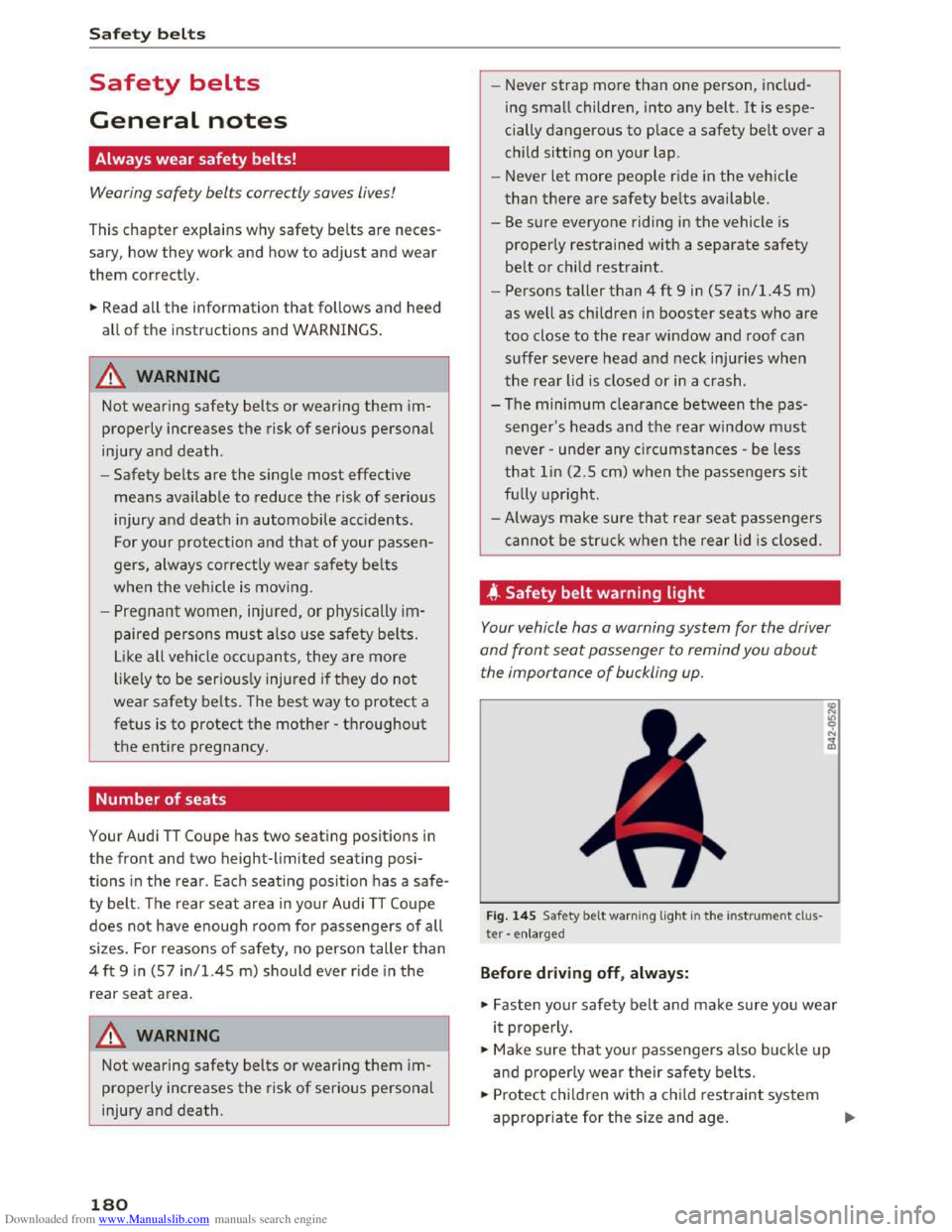
Downloaded from www.Manualslib.com manuals search engine Safety belts
Safety belts
General notes
Always wear safety belts!
Wearing safety belts correctly saves lives!
This chapter explains why safety belts are neces
sary, how
they work and how to adjust and wear
them correctly.
... Read all the information that follows and heed
all of the instructions and WARNINGS.
A WARNING
Not wearing safety belts or wearing them im
properly
increases the risk of serious personal
injury and death.
-Safety belts are the s ingle most effective
means available to reduce the risk of serious
injury and death in automobile acc idents.
For your protection and that of your passen
gers, always co rre ctly wea r safety belts
when the vehicle is moving.
-
Pregnant women , inju red, or physically im
paired
persons must also use safety belts.
L
ike all vehicle occupants, they are more
likely to
be serio us ly injured if they do not
wea r safety belts. The best way to protect a
fetus is to protect the mother -throughout
the entire pregnancy.
Number of seats
Your Audi TI Coupe has two seating positions in
the front and two height-limited seating posi
tions in the rear . Each seating position has a safe
ty
belt. T he rear seat area in your Audi TT Coupe
does not have enough room fo r passengers of all
sizes. For
reasons of safety, no person taller than
4 ft 9 in (S 7 i n/1.45 m) should ever ride in the
rear seat area.
A WARNING
t--=
Not wear ing safety belts or wearing them im-
properly
increases the risk of serio us personal
injury and death.
180
- Never strap more than one person, includ
ing
small children, into any belt. It is espe
cially dangerous to place a safety be lt over a
child
sitting on your lap.
- Never
let more people ride in the vehicle
than there are safety belts available.
-
Be sure everyone riding in the vehicle is
properl y restrained with a separate safety
belt o r child restraint.
-
Persons taller than 4 ft 9 in (57 in/1.45 m)
as well as children in booster seats who are
too close to the rear window and roof ca n
suffer severe head and nec k injuries when
the rea r lid is closed or in a crash.
- The
minimum clearance between the pas
senger's heads and the rear window must
never -un de r any circumstances -be less
that lin (2.5 cm) when th e passengers sit
fu lly upright.
-Always make sure that rear seat passengers
cannot be stru c k when the rear lid is closed.
4 Safety belt warning light
Your vehicle has a warning system for the driver
and front seat passenger to remind you about
the importance of buckling up.
Fig. 145 Safety belt warning lig ht in the instrument cl us
ter - e nla rged
Before driving off, always:
... Fasten your safety belt and make sure you wear
it properly.
... Mak e sure that you r passengers also bu ck le up
and properly wear th e ir safety belts.
... Protect chi ld ren with a ch ild restraint system
appropriate for the size and age.
Page 183 of 322
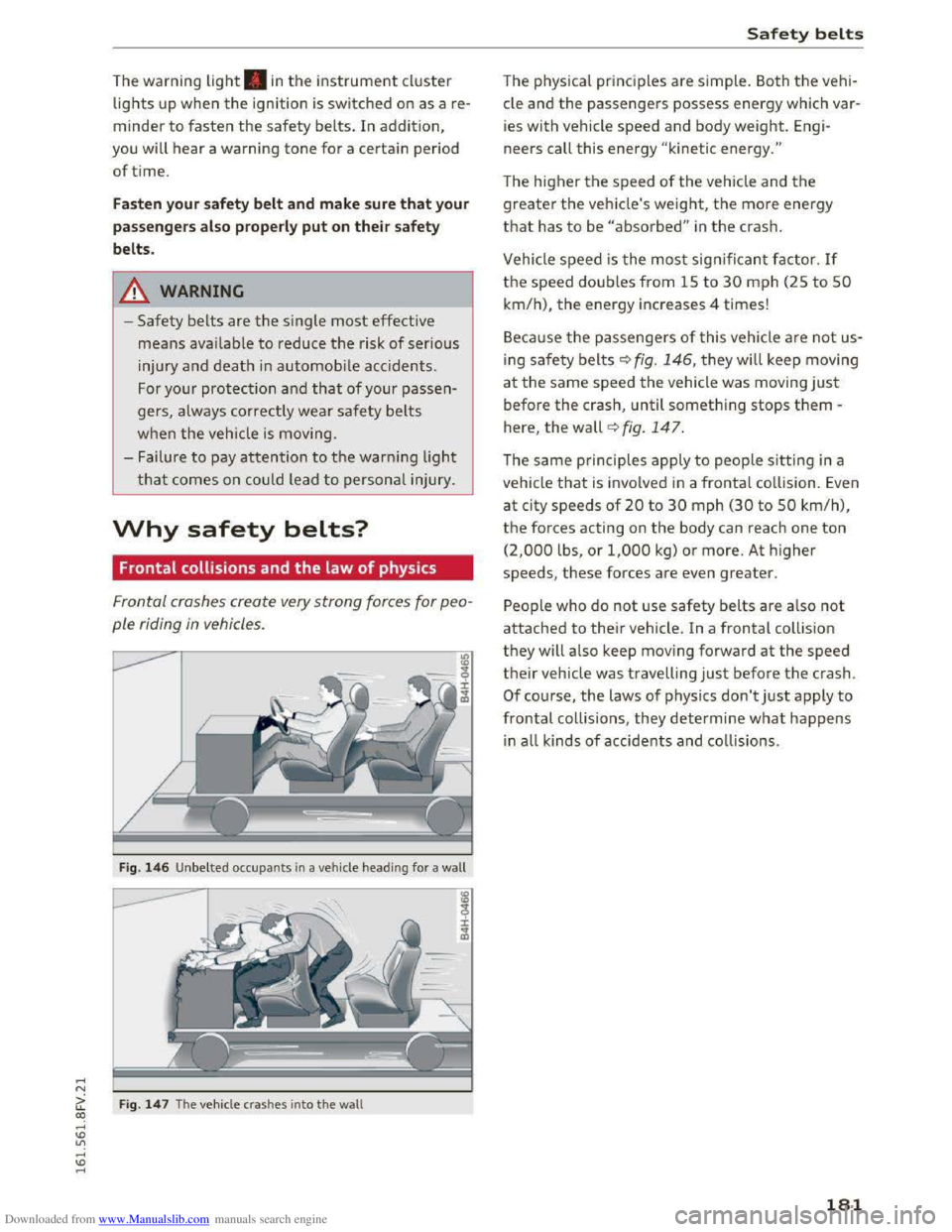
Downloaded from www.Manualslib.com manuals search engine .... N
The warning light. in the instrument cluster
lights up when the ignition is switched on as a re
minder to fasten the safety belts. In addition,
you will
hear a warning tone for a certain period
of time.
Fasten you r safet y belt and make su re that you r
pas sengers also prop erly put on
their safety
b elts .
A WARNING
-Safety belts are the single most effective
means available to reduce the risk of serious
injury and death in automobile accidents .
For your
protection and that of your passen
gers, always correct ly wear safety be lts
when the veh icle is moving .
- Failure
to pay attention to th e warning ligh t
t
hat comes on could lead to persona l injury.
Why safety belts?
Frontal collisions and the law of physics
Frontal crashes create very
strong forces for peo
ple riding in vehicles.
Fig. 146 U nbelted occupants in a veh icle headin g for a wall
Ci: Fig. 14 7 The vehicle crashes into the wall CX)
....
"' U"I
....
"' ....
Safety belt s
The physical principles are simple. Both the vehi
cle and
the passengers possess energy which var
ies with vehicle
speed and body weight. Engi
neers call this energy "kinetic energy."
The higher the speed of the vehicle and the
greater the vehicle's weight, the more energy
that has to be "absorbed" in the crash.
Vehicle speed is the most significan t factor. If
the speed doubles from 15 to 30 mph (25 to 50
km/h), the energy increases 4 times!
B ecau
se the passengers of t his vehicle are not us
ing
saf e ty belts~ fig. 146, they will keep moving
at the same speed the vehicle was moving just
before the crash, until something stops them -
here, the wall~ fig. 147.
The same principles apply to people sitting in a
vehicle
that is invo lved in a frontal co llision. Even
at city speeds of 20 to 30 mph (30 to 50 km/h),
the forces acting on the body can reach one ton
(2,000 lbs, or 1,000 kg) or more. At higher
speeds, these forces are even greater.
People who do not use safety belts are also not
attached to thei r vehicle. In a frontal coll is ion
they will also keep moving forward at the speed
their vehicle was travelling just before the crash .
Of course, the laws of physics don't just apply to
frontal collisions , they determine what happens
in all kinds of accide nts and collisions .
181
Page 184 of 322

Downloaded from www.Manualslib.com manuals search engine Safety belts
What happens to occupants not wearing
safety belts?
In crashes unbelted occupants cannot stop
themselves from flying forward and being in
jured or killed . Alway s wear your
safety belts!
Fig. 148 A driver not wearing a safety belt is violently
thrown forward
F ig .
149 A rear passenger not wearing a safety belt will fly
forward and strike
the driver
Unbelted occupants are not able to resist the tre
mendous forces of impact by holding tight or
bracing themselves. Without the benefit of safe
ty restraint systems, the unrestrained occupant
will slam violently into the steering wheel, in
strument panel, windshield, or whatever else is
in the way q fig. 148. This impact with the vehi
cle i
nterior has all the energy they had just be
fore
the crash.
Never rely
on airbags alone for protection. Even
when
they deploy, airbags provide only additional
protection . Airbags are not supposed to deploy in
all kinds of accidents. Although your Audi is
equipped with airbags, all vehicle occupants, in
cluding
the driver, must wear safety belts cor
rectly
in order to minimize the risk of severe in
jury
or death in a crash.
182
Remember too, that airbags will deploy only
once
and that your safety belts are always there
to offer protection in those accidents in which
airbags
are not supposed to deploy or when they
have already deployed. Unbelted occupants can
also be thrown out of the vehicle where even
more severe or fatal injuries can occur .
I t is
also important for the rear passengers to
wear safety belts correctly. Unbelted passengers
in the rear seats endanger not only themselves
but also the driver and other passengers
~fig. 149. In a frontal collision they will be
thrown forward violently, where they can hit and
injure the driver and/or front seat passenger.
Safety belts protect
People think it's possible to use the hands to
brace
the body in a minor collision . It's simply
not true!
Fig. 150 Driver is correctly restrained in a sudden braking
man euver.
Safety belts used properly can make a big diffe r
ence. Safety
belts help to keep passengers in
their seats, gradually reduce energy leve ls ap
pli ed
to the body In an accident, and help prevent
the uncontrolled movement that can cause seri
ous injuries . In addition, safety belts reduce the
danger of being thrown out of the vehicle.
Safety belts attach passengers to the car and give
them the benefit of being slowed down more
gently or "softly" through the "give" in the safety
belts, crush zones and other safety features engi
neered into today's vehicles. By "absorbing" the
kinetic energy over a longer period of time, the
safety belts make the forces on the body more
"tolerable" and less likely to cause injury . .,..
Page 185 of 322
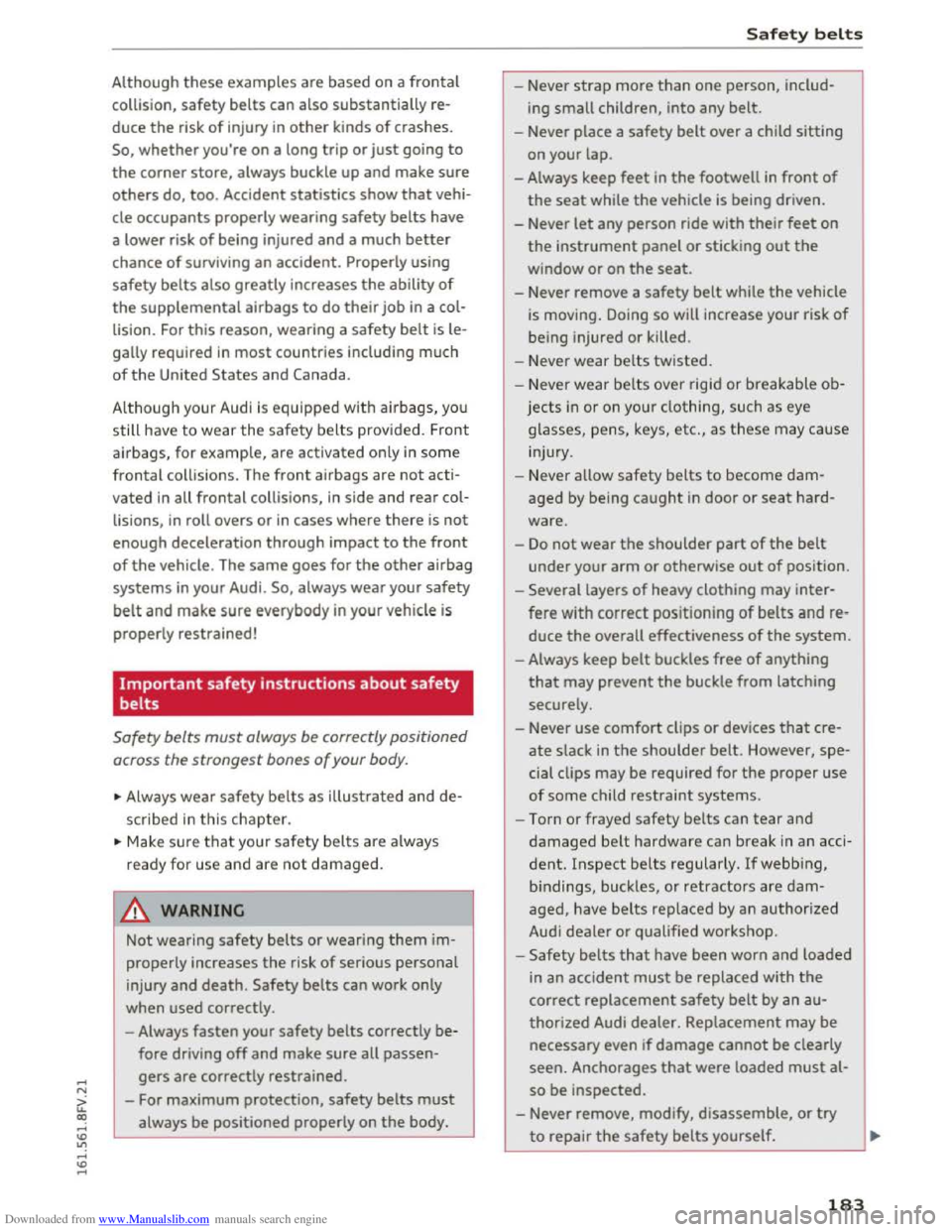
Downloaded from www.Manualslib.com manuals search engine ...... N
> u. CX> ...... u:>
"' ...... u:> ......
Although these examples are based on a frontal
collision, safety belts can also substantially re
duce the risk of injury in other kinds of crashes.
So, whether you're on a long trip or just going to
the corner store, always buckle up and make sure
others do, too. Accident statistics show that vehi
cle
occupants properly wearing safety belts have
a lower risk
of being injured and a much better
chance of surviving an accident. Properly using
safety belts also greatly increases the ability of
the supplemental airbags to do their job in a col
lision. For
this reason, wearing a safety belt is le
gally required
in most countries including much
of the United States and Canada.
Although your Audi is equipped with airbags, you
still have to wear the safety belts provided. Front
a irb
ags, for example, are activated only in some
frontal collisions. The front airbags are not acti
vated
in all frontal collisions, in side and rear col
lisions,
in roll overs or in cases where there is not
enough deceleration through impact to the front
of the vehicle . The same goes for the other airbag
systems in your Audi. So, always wear your safety
belt and make sure everybody in your vehicle is
properly restrained!
Important safety instructions about safety
belts
Safety belts
must always be correctly positioned
across the strongest bones
of your body.
"'Always wear safety belts as illustrated and de
scribed
in this chapter.
"'M ake su re that your safety belts are always
ready for use and
are not damaged.
A_ WARNING
Not wearing safety belts or wearing them im
properly increases
the risk of serious personal
injury and death. Safety belts can work only
when used correctly.
-Always fasten your safety belts correctly be
fore driving off and make sure all passen
gers are correctly restrained .
- For
maximum protection, safety belts must
always be positioned properly on the body .
Safety be lts
- Never strap more than one person, incl ud
ing
small children, into any belt.
-Never place a safety belt over a child sitting
on your lap.
- Always keep
feet in the footwell in front of
the seat while the vehicle is being driven.
- Never
let any person ride with their feet on
the instrument panel or sticking out the
window or on the seat.
-Never remove a safety belt while the vehicle
is moving. Doing
so will increase your risk of
being injured or killed.
- Never
wear belts twisted.
- N ever wear belts over rigid or breakable ob-
jects in or on your clothing, such as eye
glasses, pens, keys, etc., as these may cause
injury.
- Never allow
safety belts to become dam
aged by being caught in door or seat hard
ware.
-
Do not wear the shoulder part of the belt
under your arm or otherwise out of position.
- Several layers
of heavy clothing may inter
fere with correct positioning of belts and re
duce the overall effectiveness of the system.
-Always keep belt buckles free of anything
that may prevent the buckle from latching
securely.
- Never
use comfort clips or devices that cre
ate slack in the shoulder belt. However, spe
cial clips
may be required for the proper use
of some child restraint systems.
-Torn or frayed safety belts can tear and
damaged belt hardware can break in an acci
dent. Inspect belts regularly. If webbing,
b indings , buckles,
or retractors are dam
aged, have belts replaced by an authorized
Audi
dealer or qualified workshop.
- Safety
belts that have been worn and loaded
in an accident must be replaced with the
correct replacement safety belt by an au
thorized Audi dealer. Replacement may be
necessary even if damage cannot be clearly
seen. Anchorages that were loaded must al
so be inspected.
-Never remove, modify, disassemble, or try
to repair the safety belts yourself.
183
Page 186 of 322
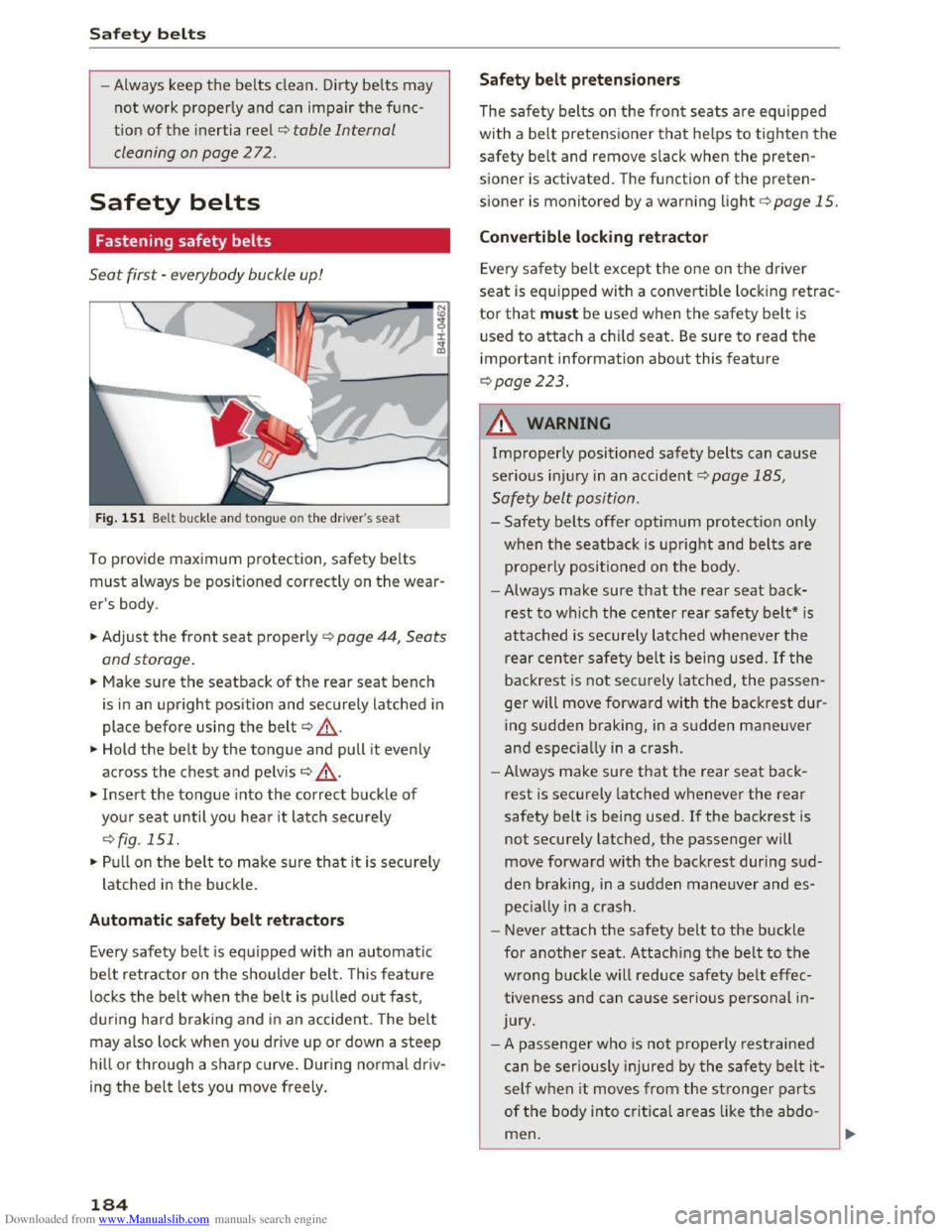
Downloaded from www.Manualslib.com manuals search engine Safety belts
-Always keep the belts clean. Dirty belts may
not work properly and can impair the func
tion
of the i nertia reel ¢table Internal
cleaning on page 272.
Safety belts
Fastening safety belts
Seat first -everybody buckle up!
Fig. 151 Belt buckle and tongue on t he driver's seat
To provide maximum protection, safety belts
must always be positioned correctly on the wear
er's body.
... Adjust the front seat properly c::> page 44, Seats
and storage.
... Make sure the seatback of the rear seat bench
is
in an upright position and securely latched in
place before using the belt¢ ,&. .
... Hold the belt by the tongue and pull it evenly
across
the chest and pelv is c::> .&_.
... Insert the tongue into the correct buckle of
your seat until you hear i t latch securely
c::>fig. 151.
... Pull on the bel t to make sure that it is securely
latched in the buck le .
Automatic safety belt retractors
Every safety belt is equipped with an automatic
belt retractor on the shoulder belt. T his feature
locks the belt when the belt is pul led out fast,
during hard braking and in an accident. The belt
may also lock when you drive up or down a steep
hill or through a sharp curve. During normal driv
ing
the belt lets you move freely.
184
Safety belt pretensioners
The safety belts on the front seats are equipped
with a belt pretensioner that helps to tighten the
safety belt and remove slack when the preten
sioner is activated. The function of the preten
sioner is monitored by a warning light c::> page 15.
Convertible locking retractor
Every safety belt except the one on the driver
seat is equipped with a convertib le locking retrac
tor that must be used when the safety belt is
used to attach a child seat. Be sure to read the
important information about this feature
c::>page223 .
.&. WARNING
Improperly positioned safety belts can cause
serious injur y in an accident .:::>page 185,
Safety belt position.
-Safety belts offer optimum protection only
when the seatback is upright and belts are
properly positioned on the body .
- Always
make sure that the rear seat back
rest to which the center rear safety belt* is
attached is securely latched whenever the
rear center safety belt is being used. If the
backrest is not securely latched, the passen
ger will move forward with the backrest dur
ing
sudden braking, in a sudden maneuver
and especiall y in a crash .
- Always
make sure that the rear seat back
rest is securely latched whenever the rear
safety belt is being used. If the backrest is
not securely latched, the passenger will
move
forward with the backrest during sud
den braking, in a sudden maneuver and es
peciall y in a crash.
- Never
attach the safety belt to the buckle
for
another seat. Attaching the belt to the
wrong buckle will reduce safety belt effec
tiveness and can cause serio us personal in
jury.
- A
passenger who is not properly restra ined
can
be seriously injured by the safety belt it
self when it moves from the stronger parts
of the body into critical areas like the abdo
men.
Page 187 of 322
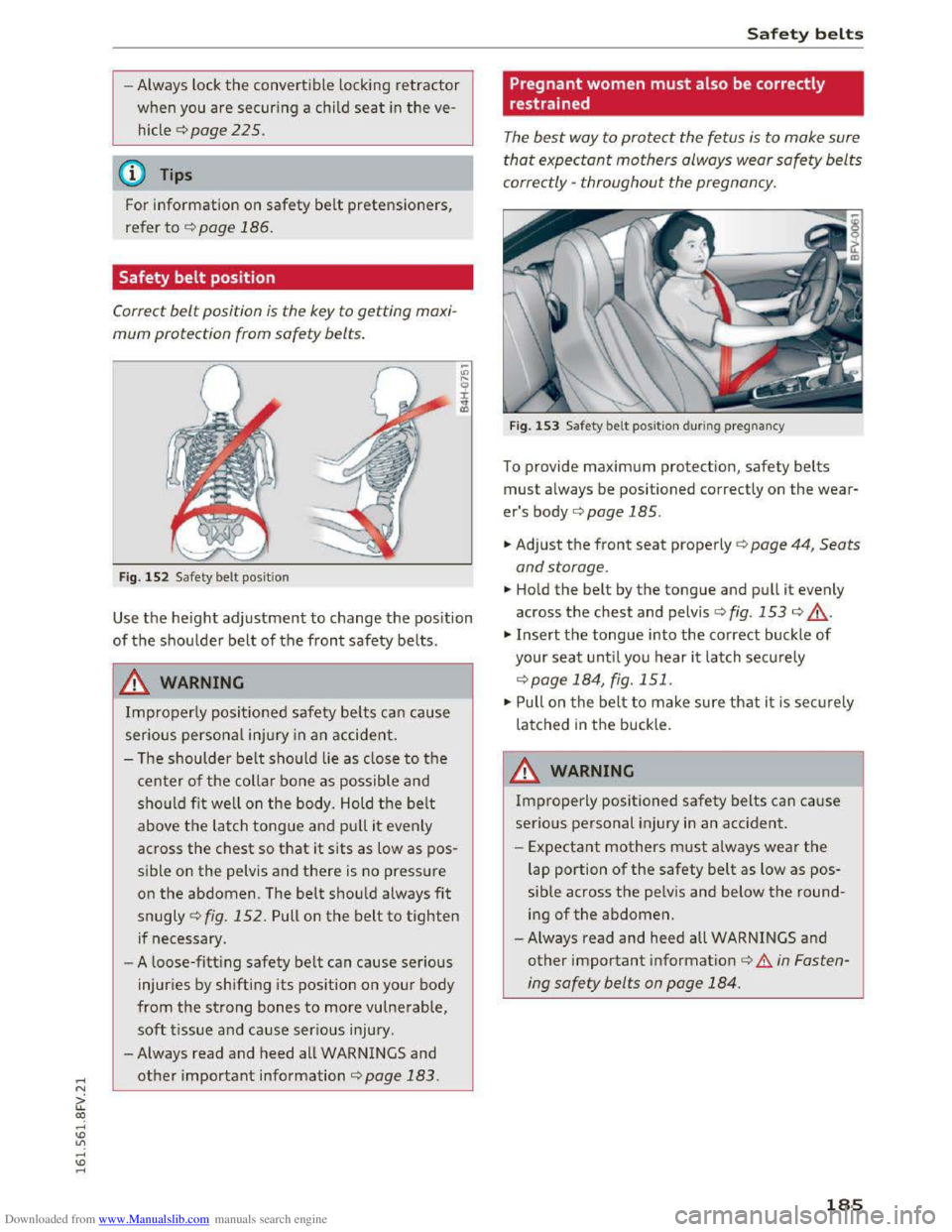
Downloaded from www.Manualslib.com manuals search engine .... N
G: CX)
....
"' U"I
....
"' ....
-Always lock the convertible locking retractor
when you are securing a child seat in the ve
hicle
¢ page 225.
@ Tips
For information on safety belt pretensioners,
refer to ¢page 186.
Safety belt position
Correct
belt position is the key to getting maxi
mum protection from safety belts.
Fig. 152 Safety belt positio n
-"' .... 9 I
"' al
Use the height adjustment to change the position
of the shoulder belt of the front safety belts.
_&WARNING
Improperly positioned safety belts can cause
serious personal injury in an accident.
- The
shoulder belt should lie as close to the
center of the collar bone as possible and
should fit well on the body. Hold the belt
above the latch tongue and pull it evenly
across
the chest so that it sits as low as pos
sible
on the pelvis and there is no pressure
on the abdomen. The belt should always fit
snugly¢ fig. 152. Pull on the belt to tighten
if necessary.
- A loose-fitting
safety belt can cause serious
injuries by shifting its position on your body
from the strong bones to more vulnerable,
soft tissue and cause serious injury.
- Always
read and heed all WARNINGS and
other important information ¢page 183 .
Safety belts
Pregnant women must also be correctly
restrained
The best way to protect the fetus is to make sure
that expectant mothers always wear safety belts
correctly
-throughout the pregnancy.
Fig. 153 Safety belt position duri ng pregnancy
To provide maximum protection, safety belts
must always be positioned correctly on the wear
er's body ¢page 185 .
... Adjust the front seat properly ¢ page 44, Seats
and storage .
... Hold the belt by the tongue and pull it evenly
across the chest and pelvis ¢ fig. 153 ¢ ..&_.
.,. Insert the tongue into the correct buckle of
your seat until you hear it latch securely
¢page 184, fig. 151 .
... Pull on the belt to make sure that it is securely
latched in the buckle.
_&WARNING
Improperly positioned safety belts can cause
serious personal injury in an accident.
- Expectant
mothers must always wear the
lap portion of the safety belt as low as pos
sible across the pelvis and below the round
ing
of the abdomen.
- Always read and heed all WARNINGS and
other important information c> .&. in Fasten
ing safety belts on page 184.
185
Page 188 of 322
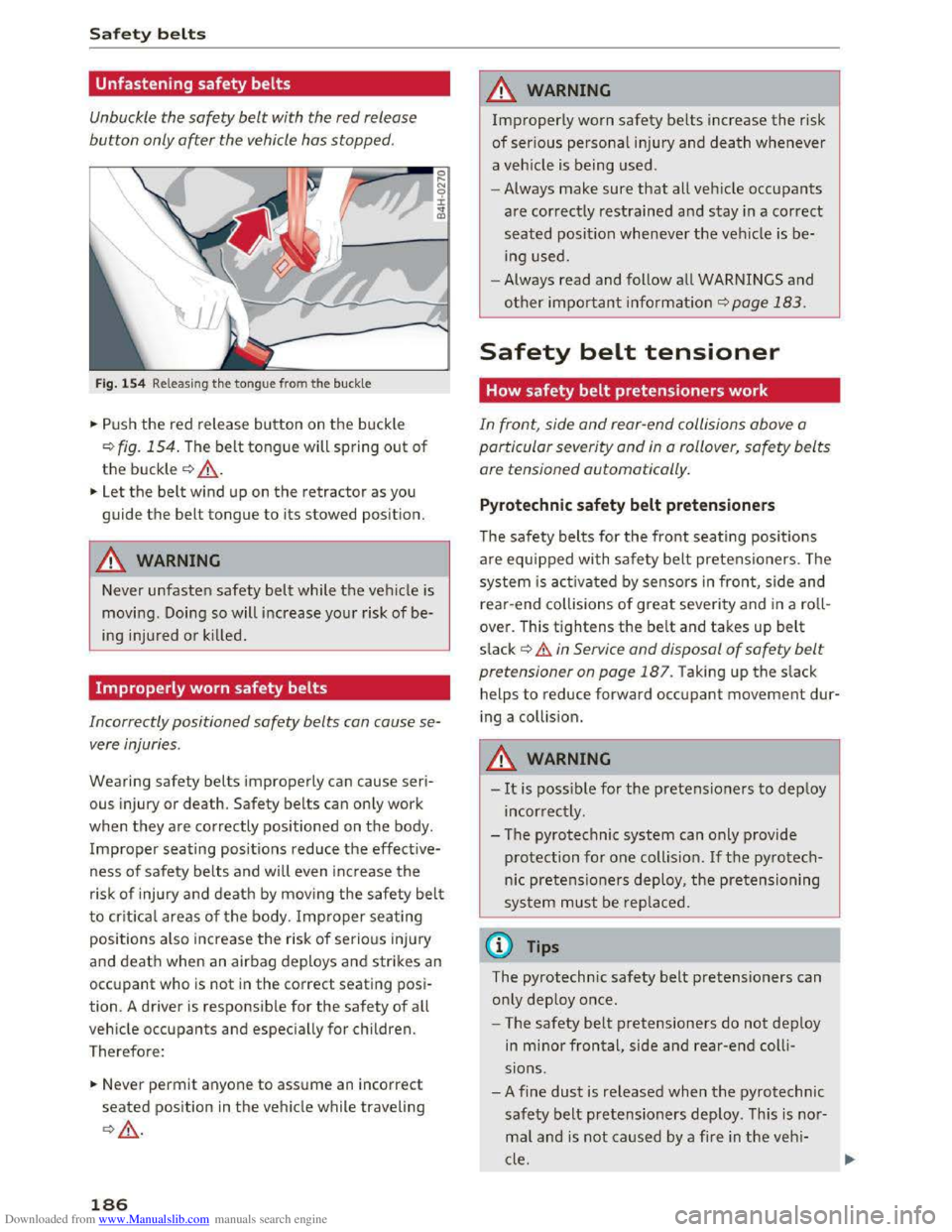
Downloaded from www.Manualslib.com manuals search engine Safety belts
Unfastening safety belts
Unbuckle the safety belt with the red release
button only after the vehicle has stopped.
Fig. 154 Releasing the tongue from the buckle
.. Push the red release button on the buckle
Q fig. 154. The belt tongue will spring out of
the buckle Q ,&..
.. Let the belt wind up on the retractor as you
guide
the belt tongue to its stowed position.
A WARNING
Never unfasten safety belt while the vehicle is
moving . Doing so will increase your risk of be
ing injured
or kil led.
Improperly worn safety belts
a
~ 0 ± .. QJ
Incorrectly positioned safety belts can cause se
vere injuries .
Wearing safety belts improperly can cause seri
ous injury or death. Safety belts can only work
when they are correctly positioned on the body.
Improper seating positions reduce the effective
ness of safety belts and wil l even increase the
risk of injury and death by mov ing the safety belt
to crit ica l areas of the body. Improper seating
positions also increase the risk of serious injury
and death when an airbag deploys and strikes an
occupant who is not in the correct seating posi
tion. A driver
is responsible for the safety of all
vehicle
occupants and especially for children.
Therefore:
.. Never permit anyone to assume an incorrect
seated position in the vehicle while traveling
QA .
186
A WARNING
Improperly worn safety belts increase the risk
of serious personal injury and death whenever
a veh icle is being used.
- Always
make sure that all veh icle occupants
are corr ectly restrained and stay in a correct
seated position whenever the vehicle is be
ing
used.
- Always read and follow all WARNINGS and
other important information Q page 183.
Safety belt tensioner
How safety belt pretensioners work
In front, side and rear-end collisions above a
particular severity
and in a rollover, safety belts
are tensioned automatically .
Pyrotechnic safety belt pretensioners
The safety belts for the front seati ng pos it io ns
are equipped with safety belt pretensioners. The
system is acti va ted by sensors in front, side and
r
ear-end collisions of great seve rity and in a roll
over. This
tightens the belt and takes up belt
s lack ~ .& in Service and disposal of safety belt
pretensioner on page 187. Taking up the slack
helps
to reduce forward occupant movement dur
i ng a collis ion.
A WARNING
-It is possi ble for the pretensioners to deploy
incorrect ly .
- The pyrotechnic
system can only provide
protection for one collision. If th e py rotech
nic pretensioners deploy, the pretensioning
sys tem must be replaced.
(!) Tips
The pyrotechnic safety belt pretensioners can
o nl y
deploy once .
- The
safety belt pretensioners do not deploy
in minor frontal, side and rear-end colli
sions .
- A
fine dust is re leased when the pyrotechnic
safety belt pretensioners deploy . This is no r
mal and is not caused by a fire in the veh i
cle.
Page 189 of 322
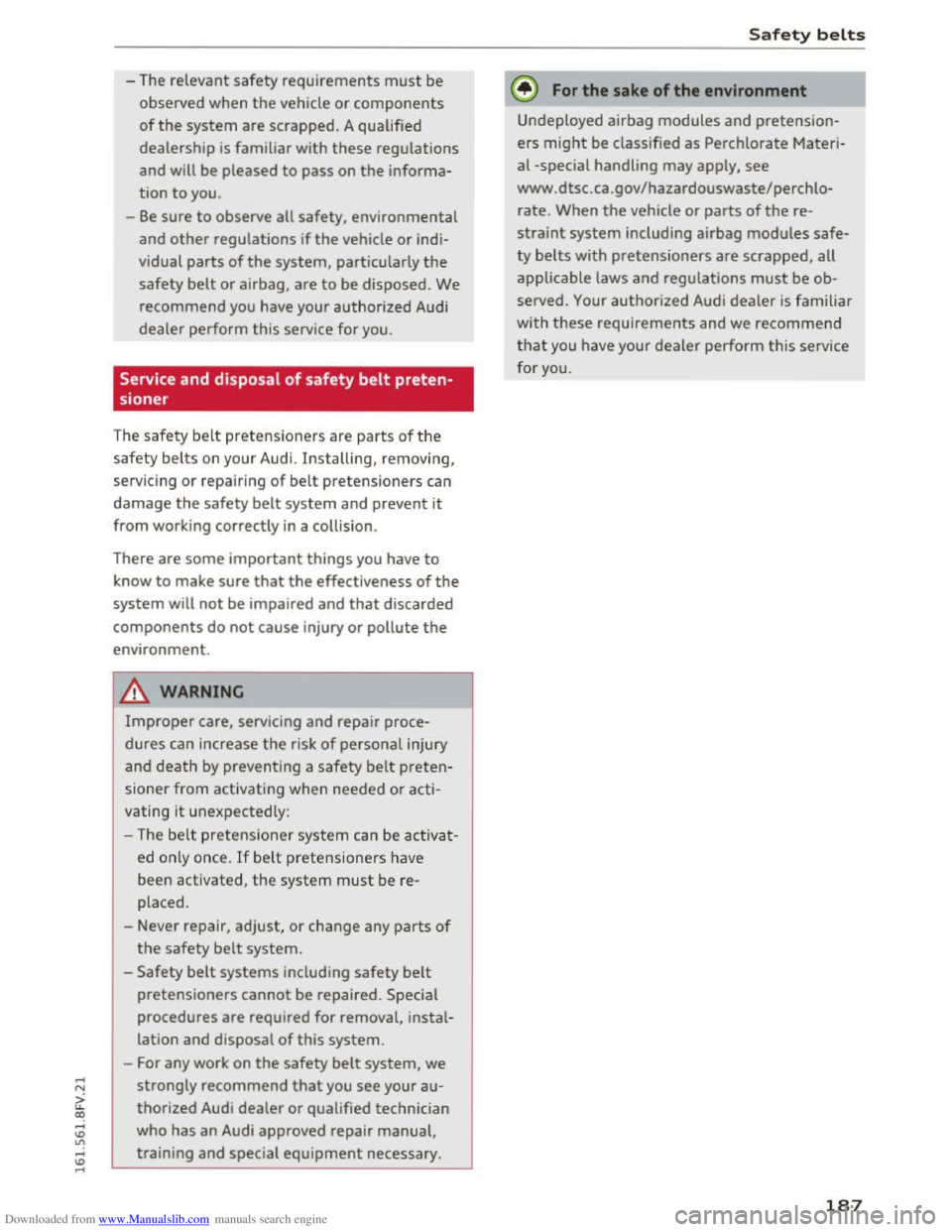
Downloaded from www.Manualslib.com manuals search engine ...... N
G'. CX)
..... ID IJ' ..... ID .....
-The relevant safety requirements must be
observed when the vehicle or components
of the system are scrapped. A qualified
dealership is familiar with these regulations
and will be pleased to pass on the informa
tion
to you.
-
Be sure to observe all safety, environmental
and other regulations if the vehicle or indi
vidual
parts of the system, particularly the
safety belt or airbag, are to be disposed. We
recommend you have your authorized Audi
dealer perform this service for you.
Service and disposal of safety belt preten
sioner
The safety be lt pretensioners are parts of the
safety belts on your Audi. Installing, removing,
servicing
or repairing of belt pretensioners can
damage the safety belt system and prevent it
from working correctly in a collision .
There
are some important things you have to
know to make sure that the effectiveness of the
system will not be impaired and that discarded
components do not cause injury or pollute the
environment.
A WARNING
-
Improper care, servicing and repair proce
dures can increase the risk of personal injury
and
death by preventing a safety belt preten
sioner from activating when needed or acti
vating it unexpectedly:
-
The belt pretensioner system can be activat
ed only once.
If belt pretensioners have
been activated, the system must be re
placed.
- Never repair, adjust,
or change any parts of
the safety belt system.
-Safety belt systems including safety belt
pretensioners cannot be repaired. Special
procedures are required for removal, instal
lation and disposal of this system.
-For any work on the safety belt system, we
strongly recommend that you see your au
thorized Audi dealer or qualified technician
who has an Audi approved repair manual,
training and special equipment necessary .
Safety belts
@ For the sake of the environment
Undeployed air bag modules and pretension
ers might be classified as Perchlorate Materi
al -special handling may apply, see
www.dtsc.ca.gov/hazardouswaste/perchlo
rate. When the vehicle or parts of the re
straint system including airbag modules safe
ty belts with pretensioners are scrapped, all
applicable laws and
regulations must be ob
served. Your authorized Audi dealer is familiar
with
these requirements and we recommend
that you have your dealer perform this service
for you.
187
Page 190 of 322
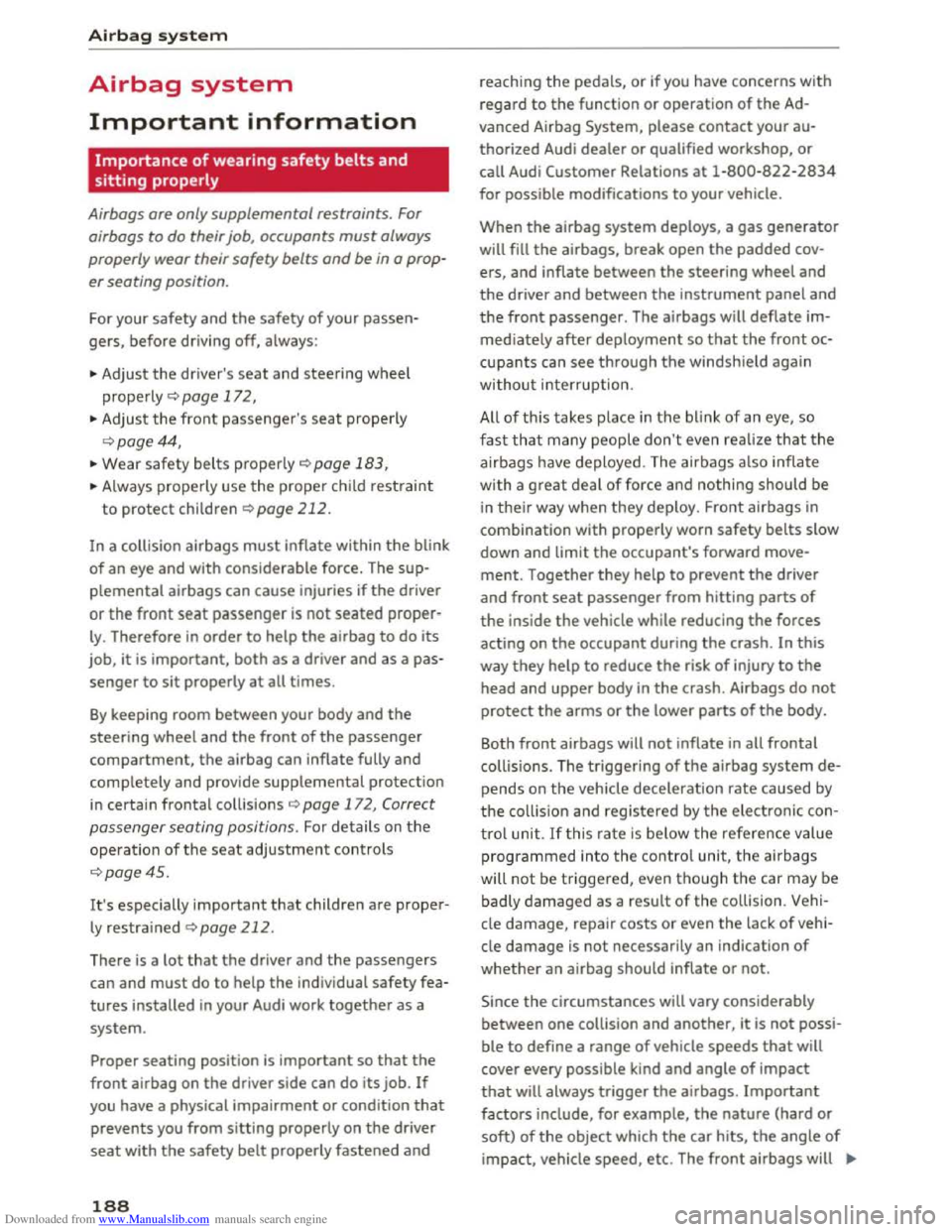
Downloaded from www.Manualslib.com manuals search engine Airbag sy stem
Airbag system
Important information
Importance of wearing safety belts and
sitting properly
Airbags are only supplemental restraints. For
airbags to do their job, occupants must always
properly wear their
safety belts and be in a prop
er seating position.
For your safety and the safety of your passen
gers, before driving off, always:
,. Adjust the driver's seat and steering wheel
properly<::;> page 172,
,. Adjust the front passenger's seat properly
¢page 44,
,. Wear safety belts properly ¢page 183,
,. Always properly use the proper child restraint
to protect children ¢page 212.
In a collision airbags must inflate within the blink
of an eye and with considerable force. The sup
plemental airbags can cause injuries if the driver
or the front seat passenger is not seated proper·
Ly. Therefore in order to help the airbag to do its
job, it is important, both as a driver and as a pas
senger to sit properly at all times.
By keeping room between your body and the
steering wheel and the front of the passenger
compartment, the airbag can inflate fully and
completely and provide supplemental protection
in certain frontal collisions r=.> page 172, Correct
passenger seating positions . For details on the
operation of the seat adjustment controls
¢page45.
It's especially important that children are proper
ly restrained¢ page 212.
There is a lot that the driver and the passengers
can and must do to help the individual safety fea
tures installed in your Audi work together as a
system.
Proper seating position is important so that the
front airbag on the driver side can do its job. If
you have a physical impairment or condition that
prevents you from sitting properly on the driver
seat wi th the safety belt properly fastened and
188
reaching the pedals, or if you have concerns with
regard to the function or operation of the Ad
vanced Airbag
System, please contact your au
thorized Audi
dealer or qualified workshop, or
call Audi Customer Relations at 1-800-822-2834
for possible modifications to your vehicle.
When the airbag system deploys , a gas generator
will fill the airbags, break open the padded cov
ers, and inflate between the steering wheel and
the driver and between the instrument panel and
the front passenger. The airbags will deflate im
mediately after deployment so that the front oc
cupants can see through the windshield again
without interruption.
All of this takes place in th e blink of an eye, so
fast that many people don't even realize that the
airbags have deployed. The airbags also inflate
with a great deal of force and nothing should be
in their way when they deploy . Front airbags in
combination with properly worn safety belts slow
down
and limit the occupant's forward move
ment. Together they help to prevent the driver
and front seat passenger from hitting parts of
the inside the vehicle while reducing the forces
acting on the occupant during the crash. In this
way they help to reduce the risk of injury to the
head and upper body in the crash. Airbags do not
protect the arms or the lower parts of the body.
Both
front a irbags will not inflate in all frontal
collisions. The triggering of the airbag system de
pends on the vehicle deceleration rate caused by
the collision and registered by the electronic con
trol unit. If this rate is below the reference value
programmed into the control unit, the airbags
will not be triggered, even though the car may be
badly
damaged as a result of the co llision. Vehi
cle
damage, repair costs or even the lack of vehi
cle
damage is not necessarily an indication of
whether an airbag should inflate or not.
Since the circumstances will vary considerably
between one collision and another, it is not possi
ble to define a range of vehicle speeds that will
cover every possible kind
and angle of impact
that will always trigger the airbags. Important
factors include, for example, the nature (hard or
soft) of the object which the car hits, the angle of
impact, vehicle speed, etc. The front airbags will Iii>